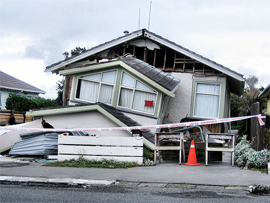
By Janine Starks

Here's a question I received recently on insurance matters in Christchurch:
My house has damage which is well over the EQC ceiling of $100,000 (the foundations have cracked right through). We have paid for a building report and this says the most likely outcome is a complete rebuild. When the EQC carried out a 15 minute visit, they put us in the category of damage under $100,000. It turns out this is wrong. However, our insurer says we still have to wait for the EQC to carry out a full assessment before they will do anything. Is there no way of bypassing the EQC inspection, given we have written evidence of how serious our situation is? It is so frustrating to just sit and wait. Should we try and put more pressure on our insurance company?
In the last month or so there has been a major change of policy at EQC. Let’s add a drum-roll for effect, because we need to add some grandeur to this news; it is now possible for your insurer to bypass the need for an EQC visit, where the damage is over $100,000.
How you ask? It is very simple.
| Email questions to starkadvice@gmail.com, subject line: Financial Agony Aunt. Anonymity is guaranteed. |
If your insurer sends out an assessor to price up the value of the repair or rebuild, they can go directly to an EQC claims office in Christchurch, which has been set up to deal with insurance companies. If they deliver written evidence of the claim being above the $100,000 maximum, EQC will tack on the GST and make the payout, without needing to visit the property. With one wave of their powerful wand, they can alleviate the waiting time and allow the insurer to proceed with the work.
It’s a cause for celebration and they deserve a big pat on the back for finally sorting it out. When I called EQC a few weeks ago, I asked the same question several times, in different ways, to make sure I was hearing it correctly. In fact, I was quite painful and sent their poor media-man away to double check and double check again.
After the September quake, the bottleneck caused by EQC was a major bone of contention for policyholders and insurers. There was no way of bypassing the EQC queue, when it was blatantly obvious the damage was in excess of the $100,000 limit.
On my own home, we were in possession of an engineering report, two quotes from master builders, a report from our insurer which agreed the house had to be pulled down and a geotech report on the land. Despite all the documentary proof, EQC would not budge. We all sat and twiddled our thumbs for four months.
EQC bypass will alleviate pressure points
The February quake has created a much longer waiting time and larger bottleneck, so it’s now crucial that insurers take advantage of the change in policy.
Policyholders need to be aware their insurer can cut through the waiting time and put pressure on them to do so. So the short answer to your question is, yes, you should ring your insurer and complain like billy-o. There is absolutely no need to wait for EQC if the damage is clearly over the limit.
Given this is a fairly recent change of policy, EQC did admit to me that not many insurers were using this route yet. It’s no wonder – they haven’t exactly publicised it widely. The back offices of insurance companies are probably not entirely familiar with it yet. Policyholders will probably have to put pressure on their insurer to take the bypass and not get fobbed off with ‘you’ll have to wait for your EQC visit’.
In your case you did the right thing by getting a building report on your home, to prove the seriousness of the damage to your insurer. On this basis, they should be happy to send their own engineers and quant surveyors to price up. They can then present this to EQC and obtain the maximum payout.
One note of caution for other people in this situation – to get things moving more quickly with your insurer, you may have to commit some of your own money and get a builders or engineers report. If the damage is around the $100,000 mark, your insurer may well prefer to wait for an EQC assessment.
My gut reaction is the bypass will work most smoothly when the damage to your home is significantly in excess of $100,000 and you are in a location which has not suffered land damage.
Land damage situations do not apply
If your home is on damaged land (such as the liquefied areas) your insurer will be forced to wait for an EQC decision on the land, before actioning a rebuild or repair.
Mind you, if your house is un-saveable, your insurer may as well press on and assess the replacement cost.
These assessments take weeks and often involve waiting in a queue for an engineer, quant surveyor and builder.
While waiting on a land decision, they can at least use the time wisely and work out the budget for a rebuild or cash-settlement on the house. There is a lot of paperwork to do before any real action takes place, so the less thumb-twiddling the better.
For everyone who is able to bypass the queue, it lessens the strain on the EQC inspection teams and surely shortens the timeframe for others. That’s got to be good news for everyone.
On a final note, anecdotal evidence indicated that AMI were refusing to help their customers bypass the EQC visit. They now tell me they’ve been able to change this, as EQC have given them approval to carry out assessments. If you are an AMI customer with serious damage and were told to wait for your EQC visit, jump back on the phone.
Email questions to starkadvice@gmail.com, subject line: Financial Agony Aunt. Anonymity is guaranteed.
Janine Starks is Co-Managing Director of Liontamer Investments. Opinions in this column represent her personal views and are not made on behalf of Liontamer. These opinions are general in nature and are not a recommendation, opinion or guidance to any individuals in relation to acquiring or disposing of a financial product. Readers should not rely on these opinions and should always seek specific independent financial advice appropriate to their own individual circumstances.
We welcome your comments below. If you are not already registered, please register to comment
Remember we welcome robust, respectful and insightful debate. We don't welcome abusive or defamatory comments and will de-register those repeatedly making such comments. Our current comment policy is here.